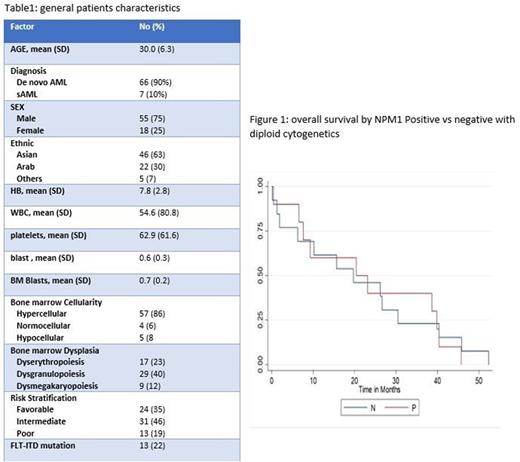Abstract
Background
Acute myeloid leukemia (AML) is a disease of elderly with a median age at diagnosis of 68-70 years. Adolescent and Young Adult (AYA) patients are defined as patients between 15-39 years of age. There is few and diverse information regarding AML in AYA patients. . Unlike acute lymphoblastic leukemia in AYA, the prognosis of AML in this age group is known to be poor. This despite despite the advances in AML therapy with most the data and clinical trials coming from pediatric groups.
With this retrospective study we describe the clinical characteristics, cytogenetics, molecular prognostic markers, treatments given and outcomes of AML in AYA patients.
Methods
We retrospectively analyzed data from the clinical database of our single tertiary hematology center, The National Center for Cancer Care and Research, Doha, Qatar. This center serves a country population of about 2, 8 million people with an estimated median age of 32, 2 years. All patients diagnosed with AML between the age of 15- 39 years during the period ofJanuary 2017 to December 2021 where included.
Results:
Seventy-three AYA patients with AML were identified from a total of 186 AML patients treated at our center (39.2%). Males were predominant 59/73 (75 %) with a median age of 30 years (range, 15-39). Most of the patients were from Asian 63%. At diagnosis the Complete blood count showed a median hemoglobin of 8.5g/dl, white blood cells of 54,000 and platelets 62,000, median blast percentage of 60% in peripheral blood and 70 % in bone marrow. Bone marrow had high cellularity in the majority (77%) of patients and was hypocellular in only5 cases (8%). Bone marrow dysplasia was reported with dysgranulopoiesis in 29%, dyserythropoiesis in 17 % and dysmegakaryopoiesis in 9% of patients. Sixty-six patients (90%) had de novo AML, while 7 (10%) had secondary AML. Most recurrent cytogenetics were diploid cytogenetics in 24 patients (32.8%), followed by CBF rearrangement in 22 patients (30%). AML disease cytogenetics was classified as Favorable risk in 24 patients (35%), intermediate risk in 31 patients (46%) and high riskas in 13 patients (19%). FLT 3-ITD was positive in 13 patients (22%) and NPM1 mutation in 10 patients (17%). Anthracycline-Cytarabine based regimen (3+7) was used as induction chemotherapy while Fludarabine-Cytarabine-Anthracycline (FLAG-Ida) based regimen was needed as salvage therapy in 34% of cases. . Twenty-three patients (31%) underwent allogenic bone marrow transplant. After a median duration of follow up of 24.8 months, a total of 21 transplanted patients (91 %) were alive. Patient characteristics are described in Table 1.
The median overall survival (OS) and progression free survival (PFS) for AYA patients with AML was 23.60 months and 23.14 months respectively. The mean duration of OS for patients with normal Karyotype having positive NPM1 or negative NPM1 was 24.8 months and 21.3 months respectively (p= 0.8) (Figure 1).
Conclusion
In this country with a very young population, the proportion of AML patients at the AYA age was high (39%) the majority being Asian males. Favorable cytogenetics are frequent at this young age group. In the intermediate risk group, NPM11 positivity gave an OS and PFS advantages. However, this was not statistically significant, possibly due to small number of samples and short follow-up duration. As expected, Patients who received allogenic bone marrow transplant had a favorable outcome and the transplantation related mortality was low. We observed a high overall survival rate among AYA AML patients
Disclosures
No relevant conflicts of interest to declare.
Author notes
Asterisk with author names denotes non-ASH members.


This feature is available to Subscribers Only
Sign In or Create an Account Close Modal